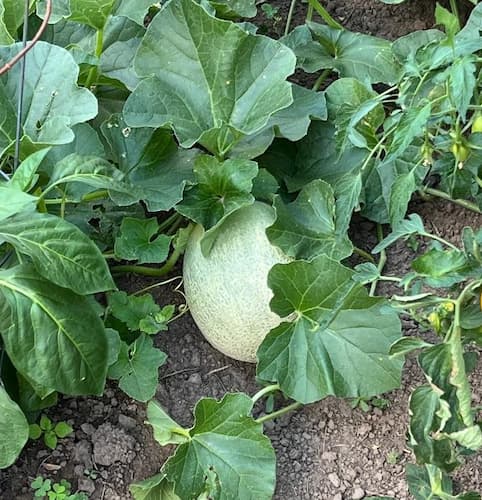How to Grow Cantaloupe or Melon Fruit

How to Grow Cantaloupe
Learn how to grow cantaloupe melons with this garden guide. If you’ve grown them before, we’re certain you will pick up a new growing tip or technique.
Now for the big question? Is it a Melon, a Cantaloupe, or a muskmelon? As a matter of fact, people call Cantaloupes by all three names. Does it really matter? We don’t think so. Any fruit that tastes this good, and is served at breakfast, lunch, dinner, and snack time, can be called anything you want to call it.
A cousin of the watermelon, cantaloupes have a sweet, musky taste, and are mouth-watering and delicious. Already popular in the home garden, it continues to gain in popularity. “Bush type” varieties, requiring less space, are the most popular. Bush varieties are not really a bush. Rather, they grow on a shorter, more compact vine.
When preparing a bowl of melons, two or three varieties are often used together. The color combination of orange Cantaloupes, mixed with green-colored Honeydew melons is aesthetically pleasing. Food that looks good, tastes even better.
Varieties of Melons
Cantaloupe and Muskmelons- There are several varieties, including early and bush types. And each variety is oh so juicy.
Honeydew Melons- This is a sweet, light-tasting melon. The flesh is lime green to light green. It adds good color when mixed with other varieties of melons in a fruit bowl.
Crenshaw Melon- Another, less common melon with a peach-colored fruit and yellow skin.

How to Grow Cantalopue
Cantaloupe plants are very susceptible to frost. And, cold weather can stunt the growth of the young seedling. Plant cantaloupe seeds after the last frost in the spring.
Common wisdom recommends melons be planted in “hills” or groups. However, this is not a requirement. If you are growing large quantities, it may not be practical.
When planting in hills, sow four to six melon seeds per hill and space the hills four to six feet apart. Sow 1/2 to 1 inch deep. After germination, thin and keep the three or four healthiest plants. Row spacing should be five to six feet. The more compact “bush” type melon plants tolerate closer spacing.
If you choose not to hill, sow seeds three to four inches apart.
Seedlings can be started indoors. A germination mat is helpful. We recommend using peat pellets to help to minimize transplant shock.
Cantaloupe plants like lots of water and fertilizer.
Keep plants weeded. Apply a thick layer of mulch or compos It keeps weeds down, and helps to maintain soil moisture, too.
Also, See:
How to Grow Cantaloupe - Insects and Pests
Melon plants are a favorite food of a variety of insect pests. Among the most common pests are the cucumber beetle and the squash vine borer. Occasionally, other pests will invade the melon patch, too. Common insecticides such as Sevin are very effective. Treatment before the emergence of insects is recommended.
Mice and moles also enjoy melons. Many a grower has seen their melon turn to mush just before it is picked. Close inspection often reveals a mole tunnel leading under the fruit. Placing a board under the fruit is one means of deterrence. But pest control is an even better one.
Plant Disease
Melon plants are very susceptible to powdery mildew and other fungus diseases. Early treatment with fungicide is effective. If not caught early, the entire patch can be affected.
How to Grow Cantaloupe - Harvest Time
Days to Harvest: Growing melons takes most of the summer season. They require approximately 75 to 90 days, with most varieties on the higher end. While they take a while to grow, it’s worth the wait.
Determining when a melon is ripe is a bit of an art form. As a general rule, a melon is ripe when the stem begins to dry out. The end of the melon is soft when pressed with your thumb. A melon is over ripe when it is soft all over. Melons can be picked just prior to ripening. Commercial growers pick them just before they are ripe, as they ship better and keep longer.
Once harvested, it will only last about a week un-refrigerated. Melons will keep for weeks in your refrigerator.
Plant Hardiness
Cantaloupes do not like cold and frost. Plant outdoors after the last frost date for your area. If the plants still have fruit in the fall, be prepared to cover the plants on frosty nights.
Please support our site. Shop for:
- rmmatthews100@hotmail.com
- 585-721-6528
- Rochester, NY
©1999-2024 GardenersNet.Com, All Rights Reserved

